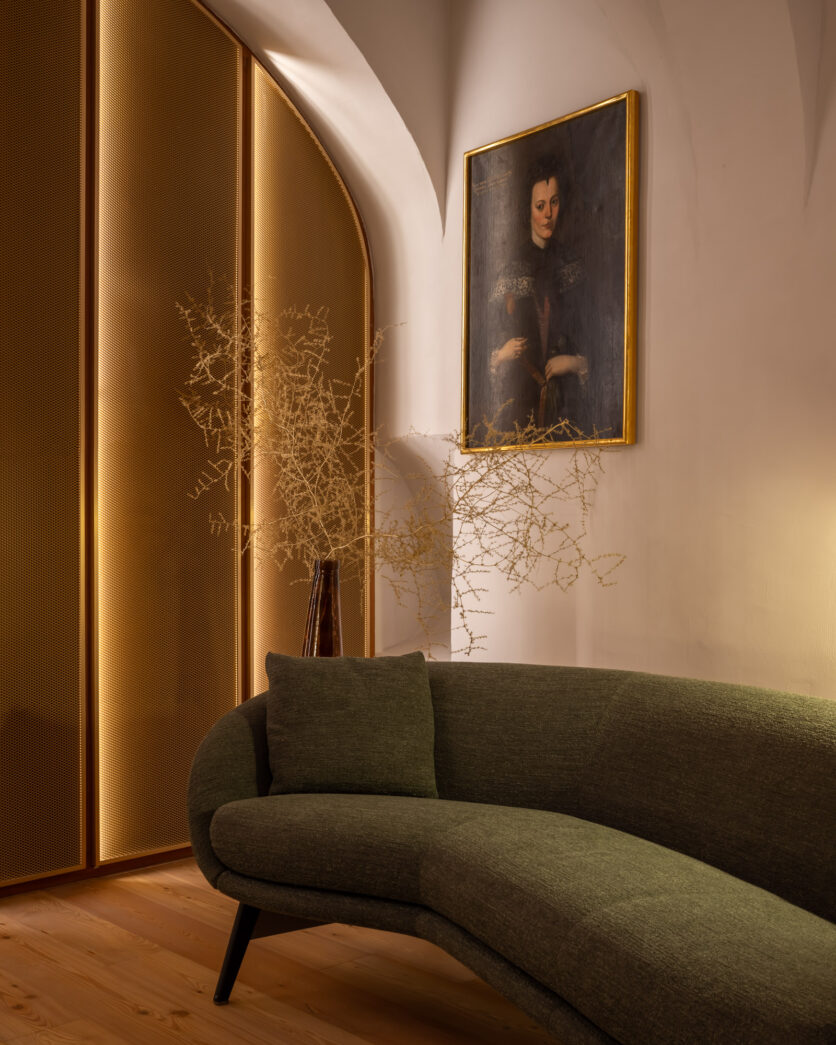Giving new life to a historic residence, finding the balance between respect for the existing and contemporary ways of living. This is what Vudafieri-Saverino Partners has done in the heart of Bressanone, South Tyrol, by reviving the use and function of a 15th-century aristocratic residence called Lasserhaus. Commissioned by the Faller family, owners of the ancient building for more than 40 years, architects Claudio Saverino and Tiziano Vudafieri have divided the spaces, transforming the first two floors into a 4-star superior Art Hotel and allocating the last two to the family’s private residence.
The new structure dedicated to hospitality consists of ten rooms – including three suites, six double rooms and a single room – with an intimate and sophisticated atmosphere, in which the Faller family’s collection of classical paintings meets works by contemporary artists, thus making the space a new point of interest for the community.For the architectural restoration and interior design of Lasserhaus, which is completely listed by the Soprintendenza Archeologia, Belle Arti e Paesaggio, the architects worked on a concept centred on the dialogue between history and contemporaneity. With an approach that has always been attentive to the context and respectful of the genius loci, the Milanese studio has reinterpreted the original elements of the residence.
The project reflects the peculiarities of the episcopal city of Brixen, which is able to blend its medieval tradition and atmosphere with avant-garde cultural proposals. Enriching the interior of Lasserhaus, located on the banks of the Isarco River and connected by a bridge to the historic city centre, are in fact the works of five artists who have confronted themselves with the residence’s past and, with their diffuse interventions, have left a narrative mark on the various spaces.
The ground floor houses the lobby and reception, a space charged with memories, characterised by soft lighting and embellished with works and family pieces. From here one accesses the first four rooms and a small lounge with a library corner for guests, as well as the wine cellar with a small tasting room, interpreted by one of the pioneers of digital art, Austrian artist Peter Kogler, using psychedelic patterns to create unusual spatial depths to be explored individually. Walking down the internal staircase leading to the mezzanine – where the architects have created a spa with sauna and whirlpool – one immediately encounters the work of Alexander Wierer, focusing on the incessant progression of time and the transience of the present. The first floor houses the breakfast room and the other five rooms.
While the period features remain visible, the rooms take on a new face thanks to the combination of natural materials such as larch and beech wood, brass, which warms and embellishes the details, and tactile, soft surfaces such as velvet. They are also characterised by the play of material textures that give three-dimensionality to the upholstery. Some of the furnishings are salvaged, such as the restored chairs typical of the Tyrolean tradition, but most of the pieces have been made to the architects’ design: from the wardrobes to the partition panels, from the velvet bedheads with brushed larch sticks to the desks, to the panelling behind the beds with minimal and elegant wood strips.
The careful study of colour has resulted in the choice of a palette inspired by the colours of the autumn woods and mountains: from the green of the shiny laminate to the brown tones declined in the red of the brushed larch, as in the warmer and darker burnt larch. Artistic incursions can also be found in some of the rooms, such as Ingrid Hora’s ‘Wall Bars’, a large work that offers guests new perspectives and encourages them to give free rein to their ideas; or ‘Thoughts and Planets’, an installation by the renowned artist Esther Stocker: ten sculptures that seem to float on the ceiling vault and dissolve fixed points through broken geometries.
In terms of lighting, Vudafieri-Saverino Partners wanted to create a cosy atmosphere, with delicate diffuse light from floor and wall lamps. In the common areas, pendant lamps were chosen instead, such as the striking chandelier in the breakfast room, where ‘Expect the best’, the work of visual artist Petra Polli, was also placed.
The Lasserhaus art project is signed by two curators: Stefanie Prieth, for the contemporary art works, and Rose Bourdon, for the family collection. These artistic interventions are only the beginning of a cultural activity that will branch out on several levels, from artist residencies to collaboration with other cultural institutions to the systematic growth of an art collection.
CREDITS
Project: Arthotel Lasserhaus
Design: Vudafieri-Saverino Partners
Location: Bressanone
Year: 2024
Forniture: Pedrali













